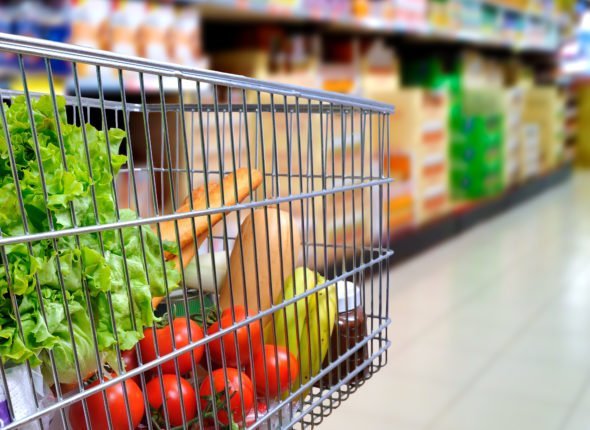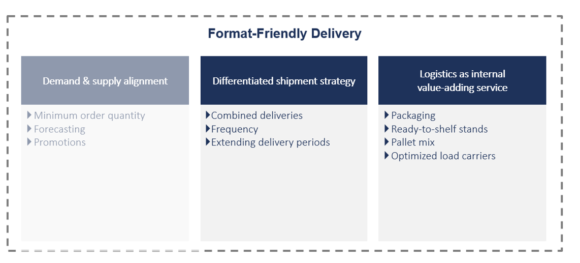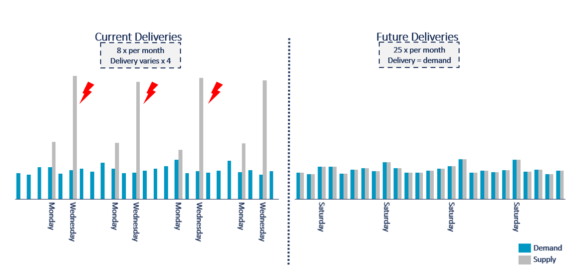A format-friendly delivery is the starting point for shaping the future grocery retail supply chain. Introducing on-demand deliveries and value-adding services in the supply chain can help to boost sales performance.
In our previous article, we have discussed format-friendly delivery as a key principle of shaping successful supply chains in grocery retail. We have shared our thoughts on aligning demand and supply for the different sales channels through adapting minimum order quantity, using advanced forecasting, and introducing new ways to manage promotions. This article will round up the starting point towards an end-to-end supply chain strategy in grocery retail with differentiated shipment strategy and logistics as an internal value adding service.
Exhibit 1 – Format-friendly delivery guidelines
Differentiated shipment strategy
It is common industry practice to delivery super fresh SKU such as fish or daily prepared meals on a very frequent basis. It is not unusual that supermarkets get delivered multiple times throughout a single day ensuring high freshness. Dry or frozen SKU on the other hand, typically get delivered less frequently. Especially convenience stores with lower demand receive less delivery attention.
On the left side of exhibit 2 an exemplary demand and supply pattern for dry goods for a convenience store is shown. The store gets delivered twice a week on Monday and Wednesday.
- The store shows an above average stock out ratio which is due to a misalignment of supply and demand. As described, for a convenience store, forecasting demand is more challenging than for a conventional supermarket. Big demand peaks are usually around the weekend. The Monday and Wednesday delivery leads to a window with less certainty, especially for the in times of higher demand. As convenience stores have only limited sales space, they are not fitted to have demand buffers, which are needed in case of problematic forecasting with long replenishment times.
- A second aspect is that the store can hardly handle the supply peaks Apart from grocery deliveries on Wednesday, the store has further deliveries from supplier direct delivery (beverages) and fresh goods on the same day. Convenience stores are run with very few personnel and have no backroom to temporarily store SKU. Delivered pallets are put directly into the sales zone. Sales personnel start to sort and refill the shelves directly from these pallets. As the three pallets might hinder each other, increased sorting, checking and refilling times are the norm. Furthermore, the customer experience is drastically reduced because part of the store is not accessible, and SKUs are not in shelf although they have been delivered.
Exhibit 2 – Exemplary demand and supply patterns
From our perspective, the delivery patterns need to be changed to better match demand.
- A key element to achieve this target for convenience stores are combined deliveries for dry and cooled goods on the basis of the fresh delivery pattern. This not only reduces the uncertainty period for dry goods but also decreases the supply peaks. The store can directly refill the SKU into the shelf. A key requisite for combined goods is of course the ability to mix and match pallets in a crossdocking area for example.
- A second solution could be extending the delivery period towards off-store hours such as night or Sunday delivery, for stores which are not limited by noise regulations. This would save delivery time due to less congested roads giving extra time for a denser delivery pattern.
- The nightly delivery should also be the favorite replenishment model for dark stores. As dark stores are not directly in city centers, regulations should not be an issue. Non same day delivery orders could be delivered easily according to the specific customer demand at the night before customer delivery from the DC to the dark store. This option would allow to use non congested roads and utilize the transport network optimally.
Logistics as an internal value-adding service
Apart from the before mentioned design choices, we see two further options to enhance store performance. In this case, supply chain ready packaging and store-friendly palletizing both improve in-store replenishment efficiency.
- Supply-chain-ready packaging is a possible option to increase efficiency. It is applicable for frequently replenished products because it reduces the time needed for placing them. On the negative side, there are additional packaging costs and a greater need for shelf space. No shelf packaging on the other hand is more flexible in store presentation, looks more appealing and does not require the additional packaging. Summing up, the choice to use shelf-ready packaging must be made on a case-by-case basis.
- Ready-to-shelf stands for promo handling should be used. Hereby full promo stands get delivered to the stores and then replenished regularly, instead of delivering stands and products separately. It requires a little more effort/investment in the robustness and system integration (multiple SKUs handling) of the stands, but it benefits in-store logistics, market responsiveness and truck exploitation. Additionally, there are now returnable promo stands with interchangeable facades.
- The SKU positioning in the warehouse shall also follow the store layout. A warehouse layout defines the picking sequence for a pallet, because a sequence is made from the articles neighboring each other. The layout generally should follow three requirements. Stack ability requires SKU which need to go to the bottom of a pallet to be picked first. Furthermore, separating articles such as food and certain non-food articles such as detergents is a must. A warehouse is secondly optimized for turnover, positioning fast movers easily accessible and slow movers at the end. Also, it is important that the warehouse ensures that product groups themselves and related product groups are stored close to each other, as they are offered in a shop, so that a pallet can be directly brought to the right aisle when replenished in store. This reduces significantly in-store replenishment times. A KPI for this recommendation is the mixing factor, which describes how many articles from the same category are on a pallet. From our experience, the mixing factor can be around 70%, when the system is optimized.
- Loading carriers handling both in replenishment and returns can also reduce effort. Much time is consumed currently with unsuitable or worn merchandise carriers (roll cages, pallets, etc.) during shelf replenishment and even more during their withdrawal and return. The load carriers must be suitable, adjustable, nesting or collapsible, and in good condition.
Exhibit 3 – Exemplary pallet mixing factor
Conclusion and Outlook
In summary, a differentiated shipment strategy with combined deliveries and extended delivery periods helps to reduce stock out and improves in-stores operations efficiency. Logistics as internal value-adding services using supply chain ready packaging and SKU positioning in the warehouse further improves in-store operations performance.
In the next article, we will present the physical supply chain network as the second guiding principle for building future grocery retail supply chain.
This post is the fourth part of our blog series on how to build a future-proof grocery retail supply chain. Further parts of the series:
Part 1: How to Shape Your Future Supply Chain – Omnichannel in Full-Assortment Grocery Retail
Part 2: The Three Principles of Future-Proof Grocery Retail Supply Chains
Part 3: Grocery Retail: How to Align the Supply Chain towards Market Demands
Part 5: Setting the Table: Designing a Supply Chain Network in Grocery Retail




